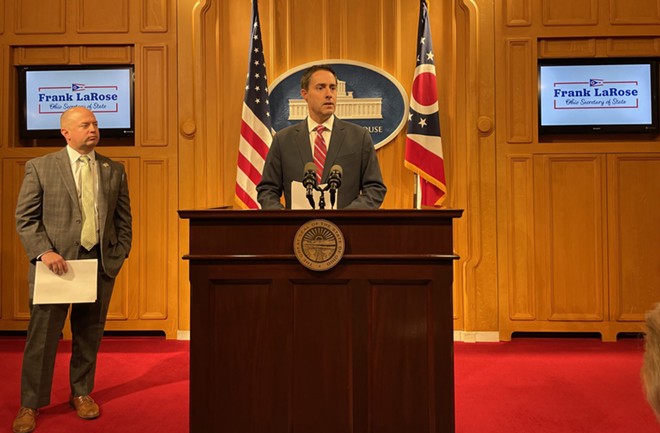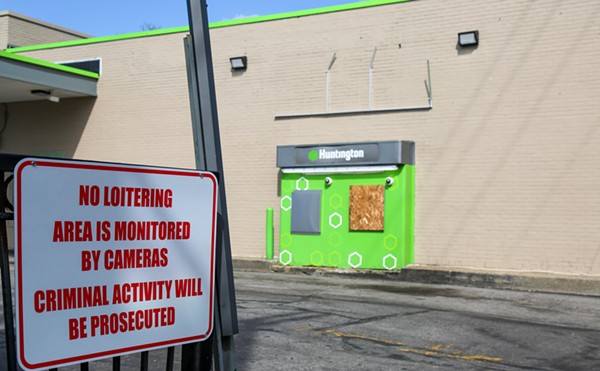
Just before lawmakers took off for Thanksgiving last year, Secretary of State Frank LaRose and state Rep. Brian Stewart, R-Ashville, held a press conference. Details ahead of time were scant, but the advisory promised “reforms which will better protect Ohio’s constitution.”
What they unveiled would dominate the chaotic final weeks of the lame duck legislative session and drive a wedge into the Republican supermajority.
In less than a month, their resolution — requiring constitutional amendments receive 60% support to become law — was effectively dead. Supporters bitterly promised they’d be back, but the episode illuminated divisions within the GOP.
This January, when Kitts Hill Republican Jason Stephens decided to make an upset bid for House Speaker, Democrats had little trouble discerning which candidate would be better for them.
Communications between Secretary LaRose, Rep. Stewart, and their staffers shed light on the behind-the-scenes maneuvering to introduce and advance House Joint Resolution 6. The effort forced a fight that’s still playing out in the Ohio House as Republican factions struggle for control.
Sixty percent
It all started with a game of phone tag. On the morning of Friday, Nov. 11 last year, Stewart turned down an apparent phone call from LaRose.
“About to give a Veterans Day speech, lol. Call you back,” Stewart texted.
Both men are veterans, and LaRose joked back that it’s “not exactly a day off” for them. By the time Stewart returned the call, LaRose was in a meeting. When LaRose called Stewart back, he didn’t pick up.
Saturday morning, Stewart sent a screen shot of an email to the Legislative Service Commission. In it, he requested a draft amendment to raise the threshold to 60% for passing citizen-initiated constitutional amendments.
“Since it is a small drafting change,” he wrote, “my hope is that it could be ready this week.”
Stewart’s next message went over talking points. He laid out their case for not applying that higher threshold to amendments initiated in the General Assembly. The change, he argued, put “interest group” amendments “on the same footing as GA-initiated amendments which require the super-majority vote at the outset.” He also asked LaRose’s office for data on constitutional amendments since 2000.
LaRose’s team got right to work, returning with a spreadsheet breakdown of all 33 proposals during that timeframe. But his chief legal counsel, D. Michael Grodhaus, warned limiting the scope to citizen-initiated measures might leave the proposal open to court challenge.
“It is possible that it may be challenged as violating Ohio’s version of the Equal Protection Clause,” he wrote, “I have not researched that point, but presumably LSC will.”
In a text message, LaRose said “one piece of good news is that the vast majority pass with over 60%.” They arranged a video conference to go over details the next day. Their press conference unveiling what would become HJR 6 was the day after that.
Building support
Before LaRose and Stewart introduced their plan publicly, they began working on legislative leaders.
The Monday after their discussion began, Stewart suggested they touch base with House Speaker Bob Cupp and Senate President Matt Huffman. LaRose said he’d already started.
“I had a tentative conversation at the OSU game with the speaker (but didn’t tell him that I was working with you on it because I didn’t want to preempt you),” LaRose wrote. “I presented it to him as ‘an idea l’ve been thinking about and want to work with you guys to get done.’”
“That’s perfect,” Stewart replied, adding that he would let the speaker know about his involvement and discuss timing. LaRose noted Cupp sounded supportive of the policy but worried about the politics.
“Seems to think it will have opponents from both the left and the right,” LaRose said.
“He had to be dragged to kicking and screaming to do the party labels for the Supreme Court as well,” Stewart responded, “but he saw the light eventually.”
The next day, Stewart relayed a conversation with Attorney General Dave Yost.
“He likes moving to 60% but thinks we will have a weak PR argument on only doing it for citizen initiatives and not legislative,” Stewart said. “He said he won’t weigh in against it, but thinks we should give that some thought.”
LaRose, meanwhile, described his exchange with Huffman. The Senate President was enthusiastic enough that he patched in chief of staff John Barron and chief legal counsel Frank Strigari. As for whether to apply the higher threshold across the board, LaRose said they discussed the idea, but it was “not conclusive.”
“He said he’d prefer 60% for initiative and 50% for legislative referral ‘if we can sell it,’” LaRose said.
Working outside the Statehouse
But at the very earliest stages — before legislative language was even complete — LaRose and Stewart were consulting power brokers outside of the Statehouse.
At the same time they were discussing Speaker Cupp’s reticence, they were also talking about Center for Christian Virtue president Aaron Baer’s involvement.
In an exchange with Stewart three days before they announced their proposal publicly, LaRose texted “I know that the life community is interested in this and Aaron Baer spoke with Huffman over the weekend.”
“Baer and I discussed it before you called me initially, too,” Stewart said.
The day before unveiling the resolution, LaRose reported speaking to Steve Stivers, who heads up the Ohio Chamber of Commerce.
“He’s for it with some additional nuance I can explain later but he’s for it,” LaRose said.
They picked up more conservative supporters after introducing the idea, but the response wasn’t unanimous.
A few hours after their introductory press conference, LaRose shared a picture of a text exchange with American Policy Roundtable vice president Rob Walgate. He had reached out to say APR would oppose the effort. “Didn’t want it to be a surprise,” Walgate said.
LaRose tried to win him over.
“Kind of surprised that you’re not part of the group of many other conservatives who believe like that me that it’s just far too easy to amend our state constitution,” LaRose wrote.
Other supporters, though, were a bit too enthusiastic. Chris Long from the Ohio Christian Alliance pitched Stewart on holding a press conference in support of the resolution.
“I think I persuaded him to work more behind the scenes directly with members without a public statement yet,” Stewart said.
LaRose agreed writing, “he should help work the conservative circles behind the scenes, but not make a big splash publicly.”
Heading to committee
The Tuesday after Thanksgiving, Stewart made his pitch to the Republican caucus. He told LaRose that while the caucus was supportive, Cupp was still “dragging feet.”
“But the sentiment in the room was that we should go to 60% for adoption across the board and undercut the ‘hypocrisy’ argument,” Stewart said.
“Can you get Cupp some reassurance that resources will be spent to advance this in May?” Stewart added.
LaRose said shifting to 60% across the board was fine with him, and that any reassurance for Cupp should come from the business community. He mentioned Steve Stivers and Ohio Business Roundtable president Pat Tiberi.
“They both told me they’re behind this 100%,” LaRose said. “I guess at this point I need to ask them to tell the speaker that, too.”
Later that day, Stewart reported they would get their first committee hearing that week.
He explained the chairman, Rep. Shane Wilkin, R-Hillsboro, and Rep. Bill Seitz, R-Cincinnati, both wanted to see the higher threshold applied to all amendments, regardless of whether they’re initiated by lawmakers or citizens. “Without them we don’t get it out of committee,” Stewart said, adding that he planned to introduce a sub bill with those changes at the start of the hearing.
By the next day, before holding a single hearing, they’d already set their course to eventual passage.
“Tomorrow is just sponsor (testimony),” Stewart said about the committee hearing on Thursday. “Plan I think (Wilkin was talking to Speaker) is for proponent/opponent to occur next week, and voted out at the end of next week or early the week of the 12th.”
This was less than two weeks after the press conference introducing the resolution.
Presaging the rift that would eventually consume the party, Stewart noted “Stephens told me he’s a no.”
A few weeks earlier the caucus had selected Rep. Derek Merrin, R-Monclova Township, to be the next House speaker over Rep. Jason Stephens, R-Kitts Hill, and Rep. Phil Plummer, R-Dayton.
“I’m going to try to ferret out if there’s more,” Stewart wrote, “There may be some post Speaker vote hangover here we are dealing with.”
Hearings
Thursday, Dec. 1, Stewart testified in the House Government Oversight Committee in favor of HJR 6. “It went really, really well,” he told LaRose later that day. “GOP members were very pleased, and the Dems couldn’t land a glove.”
Meanwhile, they notched a significant endorsement as Heritage Action announced it “fully supports” the measure. In a text message, CCV’s Aaron Baer took credit, saying “a productive trip to Washington yesterday” with a link to the press release.
LaRose promised to submit written testimony to the committee but wouldn’t be there in person. “First family vacation in close to two years,” he explained.
“Honestly, I spent an hour engaging with them,” Stewart replied, “There’s not much ground left to plow in person.”
The following Tuesday Stewart asked if they should get proponents to speak at a hearing scheduled for the next day.
“I think the more the merrier who can come in and speak in favor… You know the opposition is going to pack the room,” LaRose wrote back.
In the end, only one proponent showed up to testify in favor of the plan.
A tactical pause
This story relies on numerous images of LaRose and Stewart’s text exchanges collected through a public records request. In the initial version, many of those images are blurry and at times illegible. When LaRose’s office provided a new, legible copy those messages cut off at Dec. 6.
The original version included a few more messages stretching into the following week.
On Dec. 7, LaRose sent Stewart the contact card for the associate director of the American Petroleum Institute, without any additional comment.
The following week, LaRose reached out to talk. His message appears to read that they “may be taking a tactical pause,” adding later “I heard we’re short on votes.”
HJR 6 made it out of committee, but hundreds of opponents staged a coordinated show of resistance at the Statehouse. Later that same day, Speaker Cupp explained it was “doubtful,” the resolution would go forward.
In his response, however, Stewart remained optimistic. He wrote back to LaRose, “Merrin and I already scheduled multiple session days in January.” He added they could pass the resolution quickly “when we’ve got 67 votes” and what appears to be “several fewer hard heads to wrangle.”
The next day, a letter from Stewart to fellow Ohio House Republicans was revealed by Cleveland.com’s Andrew Tobias.
Though LaRose had denied that the resolution was about stopping proposed amendments to protect access to abortion or a new round of redistricting reform, in his letter Stewart cited two reasons for his colleagues to support raising the threshold for voters: protecting Ohio’s abortion ban and fighting further redistricting reform efforts.
Aftermath
Stewart quickly shifting gears to a January timeline aligns with what he promised publicly at the time. But of course, with Merrin losing the speaker’s race to Rep. Stephens, those House sessions never happened.
A little more than a week after Stephens took the gavel, Merrin and Stewart got their allies together at the statehouse to file a new version of the resolution. Merrin has repeatedly invoked that legislation since then as a point of differentiation between his allies and Stephens’ supporters.
The proposal now requires organizers get signatures from all 88 counties instead of the 44 required under current law. It also eliminates the cure period in which organizations can collect additional signatures if their first submission falls short.
However, the Feb. 1 deadline for amendments to get on the May ballot came and went without lawmakers holding a single hearing on Stewart’s resolution.
Stephens said he’s “confident” the chairman of a new committee devoted to constitutional amendments “will be able to handle the gravity of this issue.” Still, he didn’t even refer the measure to the committee until Feb. 16.
That committee still has yet to hold a hearing.
Originally published by the Ohio Capital Journal. Republished here with permission.








